Mushrooms seem to be popping up all over the place lately, including in people’s gardens. So why are mushrooms growing in your garden? There are a few reasons this might be happening, but don’t worry – we’re here to help! In this article, we’ll answer some common questions about why mushrooms grow in gardens, and give you some useful tips on how to get rid of them. Keep reading for more information.
Wild Mushrooms In General
Mushrooms are the fruit of a fungi, which is a plant that doesn’t produce chlorophyll like most other plants. This means that mushrooms can grow anywhere there is food for them, including your garden. Mushrooms are an important part of the ecosystem because they help break down organic matter.
In forests, most of the trees and plants are alive and well because fungi are breaking down dead leaves, branches, and logs on the forest floor. This is also why you’ll find mushrooms growing in your garden – they’re there to help break down any organic matter like fallen leaves, dead plants, or even animal droppings.
Mushrooms are spread in a few different ways. One way is by spores, which are tiny particles that are released into the air and can travel long distances before landing and growing into new mushrooms. Spores are produced by mature mushrooms and are typically found on the underside of the mushroom cap. The spores of a mushroom are spread by the wind, and can travel long distances. Once they find a suitable environment, they will start to grow. Mushroom spores are very tiny, and you need a microscope to see them.
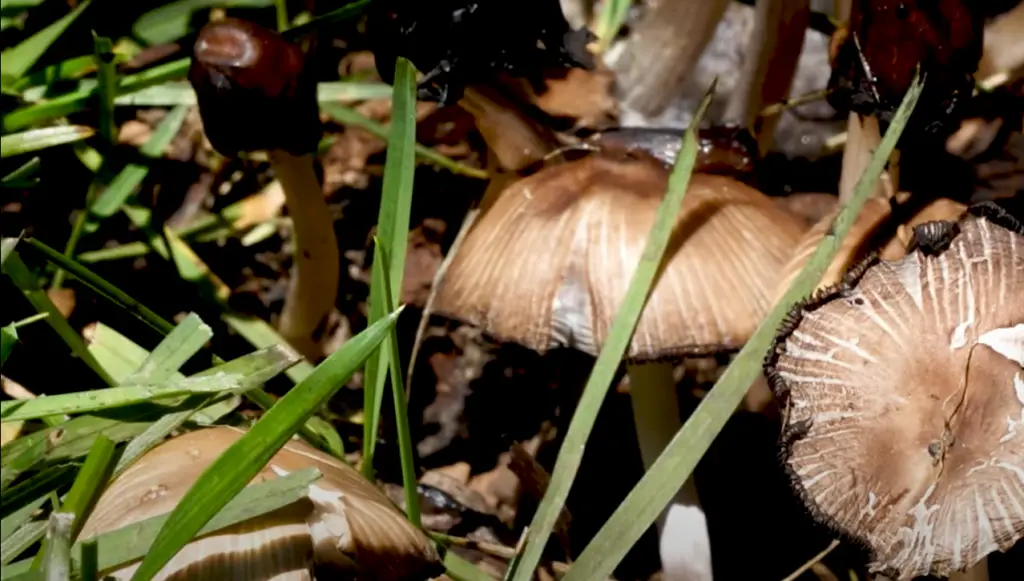
Another way mushrooms can spread is through mycelium, which are thread-like structures that make up the main body of a mushroom. Mycelium can travel through soil or water and will eventually form new mushrooms along the way. Finally, some mushrooms will produce “clones” of themselves, which are small pieces of tissue that break off from the main mushroom body and grow into new mushrooms elsewhere.
Some mushrooms are edible, while others are poisonous.
If you’re not sure, it’s best to err on the side of caution and not eat them. Some people are allergic to mushrooms, even if they’re not poisonous.
Getting rid of toxic mushrooms is especially important if you have kids or pets because they’re more likely to put things in their mouths without knowing any better. You can remove mushrooms from your garden by hand, but it’s important to wear gloves and a mask to protect yourself from spores.
Types of Garden Mushrooms
You won’t encounter the same type of mushroom in every garden. In fact, there are several different types of mushrooms that might pop up depending on the climate and location of your garden.
Shaggy ink cap (Coprinus comatus)
The shaggy ink cap is a common type of mushroom that often grows in gardens. This mushroom gets its name from the black ink-like liquid that it produces when it’s mature. The shaggy ink cap is edible, but only if you eat it when it’s young. Once this mushroom matures and starts to produce the black liquid, it becomes poisonous.
Yellow-staining mushroom (Agaricus xanthodermus)
These mushrooms are common in North America and Europe. They grow in lawns, gardens, and parks. They have a yellow cap and white stipe (stem). The flesh of the mushroom stains yellow when it’s bruised or cut. If you spot yellow-staining mushrooms growing in your garden, the best thing to do is to remove them. They are known to cause stomach upset if eaten.
What makes them dangerous, is their similarity to the edible button mushroom (Agaricus bisporus). If you’re not careful, you might mistake them for each other and end up with a stomachache.
Fly agaric (Amanita muscaria)
Fly agaric is one of the most recognizable mushrooms due to its red cap with white spots. It’s also one of the most poisonous mushrooms, so it’s important to know what it looks like. Fly agaric grows in woods and grassy areas, and can even be found in gardens.
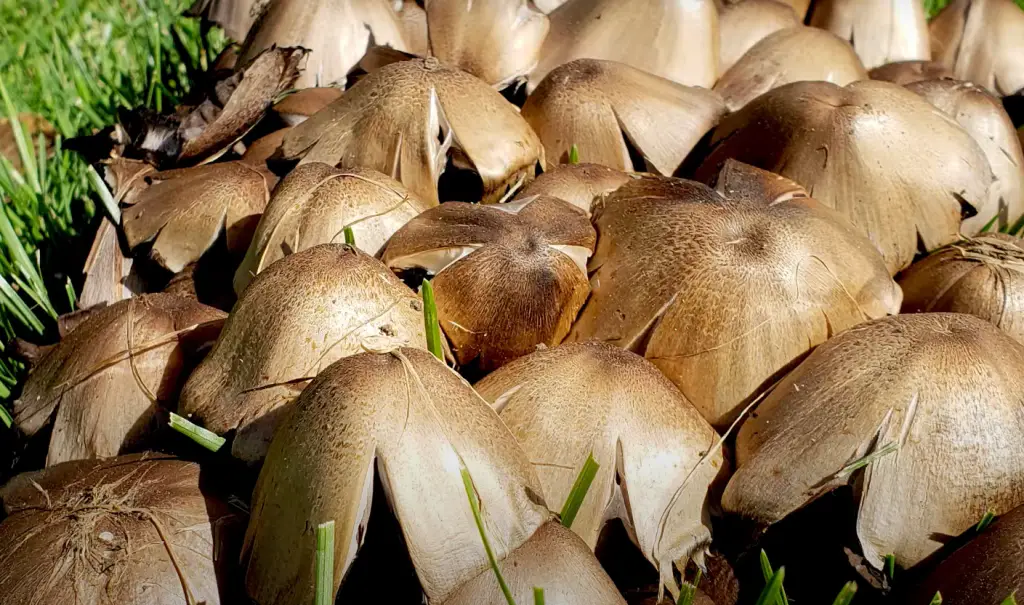
This mushroom usually appears in late summer or early autumn. If you see a fly agaric mushroom in your garden, it’s best to remove it immediately.
Field mushrooms (Agaricus campestris)
Field mushrooms are the most common type of mushroom you’ll find in gardens. They typically have a white cap with brown scales and a short, thick stem. These mushrooms can grow in any type of soil but prefer well-drained, sandy soil. You’re most likely to find field mushrooms in early spring or fall.
Sulphur tuft (Hypholoma fasciculare)
Sulphur tuft mushrooms are often found in gardens, especially on lawns. They have a yellowish-brown cap with a slightly hairy surface. The sulphur tuft mushroom gets its name from the yellowish-brown color of its spores. This mushroom is poisonous and can cause stomach upsets if eaten.
Fairy ring mushroom (Marasmius oreades)
Fairy ring mushrooms are also one of the most frequent types of mushrooms found in gardens. They get their name from the way they often grow in a circular pattern, which is said to be caused by elves or fairies dancing in a ring. Fairy ring mushrooms can be white, brown, or tan and have a small cap with gills on the underside.
These mushrooms typically grow in lawns, but can also be found in pastures, meadows, and woods. Fairy rings are usually harmless, but can cause some damage to your grass if they’re left unchecked. [1]
Why Are There Mushrooms in My Garden
So as you can see, mushrooms can be found growing in all sorts of places – in forests, on trees, in fields and even in your garden! But why are mushrooms growing in my garden?
There are many reasons why mushrooms might start growing in your garden. It could be that the conditions are right for them to grow, or there might be something else going on. Let’s take a look at some of the most common reasons why mushrooms appear in gardens.
Excessive moisture
One of the most common reasons for mushrooms growing in gardens is excessive moisture. Mushrooms need a lot of water to grow, so if your garden is constantly wet, it’s the perfect place for them to start popping up.
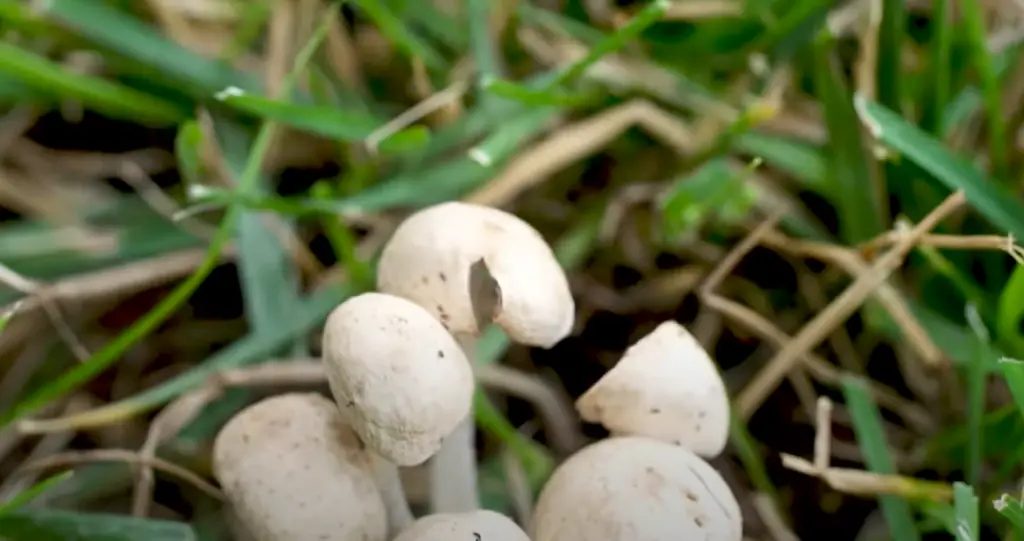
There are several ways to reduce the amount of moisture in your garden and stop mushrooms from growing. One way is to make sure that there’s proper drainage.
You can improve drainage by adding organic matter like compost or peat moss to your soil. This will help absorb excess water and prevent pools from forming.Humidity
By far the most common reason for mushrooms to appear in gardens is because of the humidity. Mushrooms need moisture to grow, so they’re more likely to appear during humid or wet periods. If you live in an area with high humidity, you might find mushrooms growing in your garden more often than people who live in dryer climates.
Another reason why mushrooms love humid conditions is because it helps them spread their spores. When the air is moist, spores can travel through the air and land on new surfaces where they can start to grow. This is why you’ll often find mushrooms growing in groups – they’ve landed there together after being carried by the wind!
Organic materials
As we mentioned before, mushrooms love organic materials. This is because they need something to decompose in order to grow. If there are a lot of decaying leaves or other organic matter in your garden, it’s the perfect place for mushrooms to start growing.
Temperature
Another factor that can affect mushroom growth is temperature. Mushrooms like cool temperatures and will often appear in spring or autumn when the weather starts to get cooler.
If you live in an area with hot summers and cold winters, you might find that mushrooms only appear during the colder months. [2],[3]
How to Prevent Mushrooms From Growing in Your Garden
Not all mushrooms are created equal. Some mushroom species are considered pests while others are perfectly harmless. If you’re concerned about mushrooms growing in your garden, there are a few things you can do to deal with them and prevent them from appearing.
Identify their location to get an idea of what’s causing them
Mushrooms can pop up virtually anywhere in your garden. If you’re noticing them in a particular spot, take note of where they’re growing. This can give you an indication of what might be causing them to grow there. For example, if they’re clustered around the base of a tree, it’s likely that the roots are responsible. If they seem to be popping up all over your lawn, on the other hand, chances are something else is to blame.
Chances are, the moisture is the culprit so it’s best to inspect the moisture levels in your soil. Maybe your irrigation system is at fault. Check for any leaks or broken sprinklers and make sure your garden is getting the right amount of water. If you’re hand-watering, take care not to overwater as this can also lead to mushrooms.
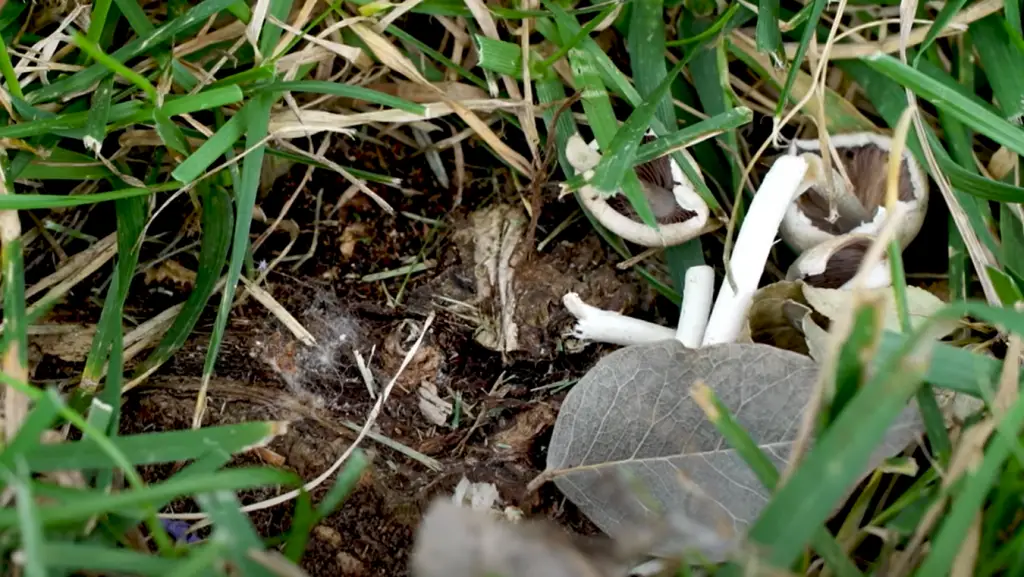
Once you’ve determined the source of the problem, you can take steps to fix it. If it’s a matter of too much moisture, make sure to adjust your watering habits accordingly. If it’s due to something like a tree root, you may need to remove the tree or at least relocate it if possible.
Get rid of existing mushrooms
If you already have mushrooms growing in your garden, the best thing to do is remove them as soon as possible. This can be tricky, as they often have long and deep roots. The best way to remove them is by digging them up with a spade or shovel. Make sure to get all of the roots out so that the mushroom doesn’t grow back.
Once you’ve removed the mushroom, dispose of it in a plastic bag. Don’t put it in your compost bin as this could spread spores and cause more mushrooms to grow.
After you’ve removed the mushroom, it’s important to take measures to prevent more from growing. As we mentioned before, this usually involves reducing moisture levels in your garden.
Don’t forget to properly clean your tools after removing mushrooms from your garden. This will help to prevent the spread of spores and ensure that you don’t inadvertently plant them somewhere else in your garden.
Improve drainage
Mushrooms grow best in damp conditions, so improving drainage in your garden is a good way to prevent them from appearing. If you have mushrooms growing in one particular area of your garden, you can try digging a trench around that area to help improve drainage. You can also add organic matter to your soil, such as compost or manure, which will help improve drainage and make it less hospitable for mushrooms.
Improve aeration
Just like with humidity, aeration, or rather lack thereof, can play a role in mushroom growth.
This can cause problems for your plants and make it easier for mushrooms to take hold.To improve aeration in your garden, you can add organic matter like compost or peat moss to your soil. This will help improve drainage and allow air to reach the roots of your plants. You can also try aerating your soil with a pitchfork or other tool. This will help break up any compacted areas and allow air to circulate better.
Doing this will not only help prevent mushrooms from growing, but it will also be beneficial for the overall health of your garden!
Recycle the organic matter
As we mentioned before, mushrooms love organic matter. If you have a lot of decaying leaves or other organic waste in your garden, it’s best to remove it and recycle it. You can do this by composting the waste or using it as mulch for your plants. This will help prevent mushrooms from growing and also improve the health of your soil.
You can utilize the recycled organic matter in your garden to improve the health of your plants and prevent mushrooms from growing. Composting is one of such ways.. Mulching with organic materials can also help improve the health of your soil and prevent mushrooms from growing.
Monitor the condition of your lawn
Mushrooms are often a sign that something is wrong with your lawn. They could be indicative of compaction, poor drainage, or a lack of nutrients. If you notice mushrooms growing in your garden, take a close look at the condition of your lawn and see if there are any areas that need to be addressed.
A healthy lawn is less likely to attract mushrooms, so make sure you’re fertilizing it regularly. You can use a balanced fertilizer that contains nitrogen, phosphorus, and potassium. Apply it according to the manufacturer’s instructions and water it deeply afterwards.
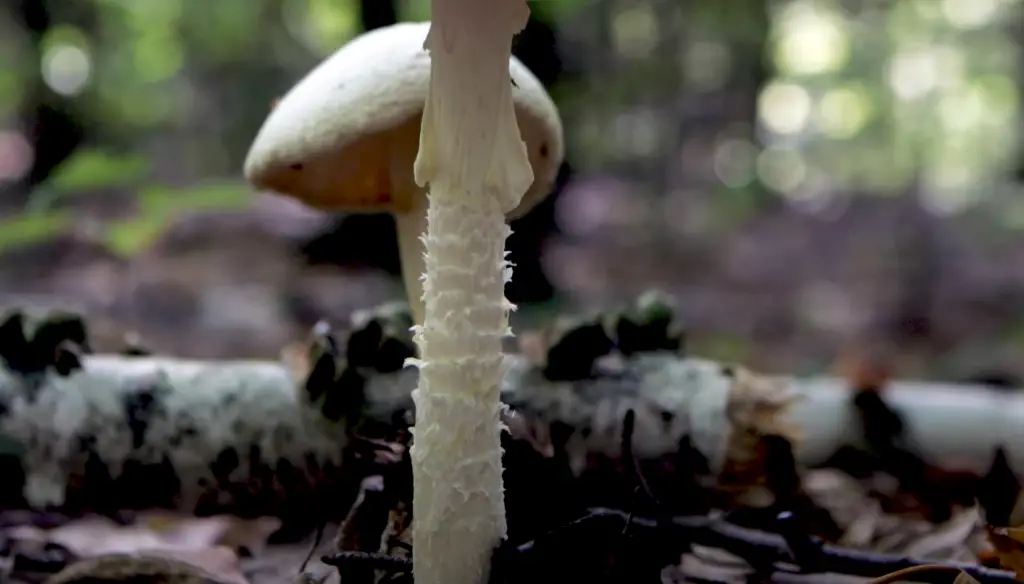
You should also mow your lawn regularly to keep the grass at a manageable height. If the grass is too long, it could start to block out sunlight and prevent air from circulating properly. This creates the perfect conditions for mushrooms to grow!
Apply fungicide
One of the best ways to prevent mushrooms from growing in your garden is to apply a fungicide. A fungicide is a chemical that is used to kill or prevent the growth of fungi. Fungi can cause diseases in plants, animals, and humans. Some fungicides are used to control mold, mildew, and rust on crops. Other fungicides are used to protect against fungal infections in people with weakened immune systems.
There are many different types of fungicides available on the market today. Some are made from natural ingredients while others contain synthetic chemicals. Natural fungicides include products like neem oil and sulfur while synthetic options include chlorothalonil and mancozeb.
When choosing a fungicide for your garden, it is important to select one that is appropriate for the type of fungi you are trying to control. It is also important to read the label carefully and follow the directions for use.
Applying a fungicide is typically a last resort, as they can be harmful to other plants and animals in your garden. If you do decide to use one, be sure to follow the directions carefully and only apply it where necessary.
They can disappear on their own
Mushrooms are often a temporary problem in gardens. They typically appear after periods of heavy rain or when the conditions are otherwise conducive to their growth. If the conditions improve, the mushrooms will often disappear on their own.
In some cases, you may need to take action to prevent mushrooms from growing in your garden. However, in most cases, they will eventually go away on their own.
Never eat the mushrooms growing in your garden
One thing you need to keep in mind upon noticing weird mushrooms growing in your garden, is to never eat the mushrooms that you randomly find. While some species of mushroom are edible, others are not and can be poisonous. If you’re not sure which kind of mushroom is growing in your garden, it’s best to err on the side of caution and avoid eating it.
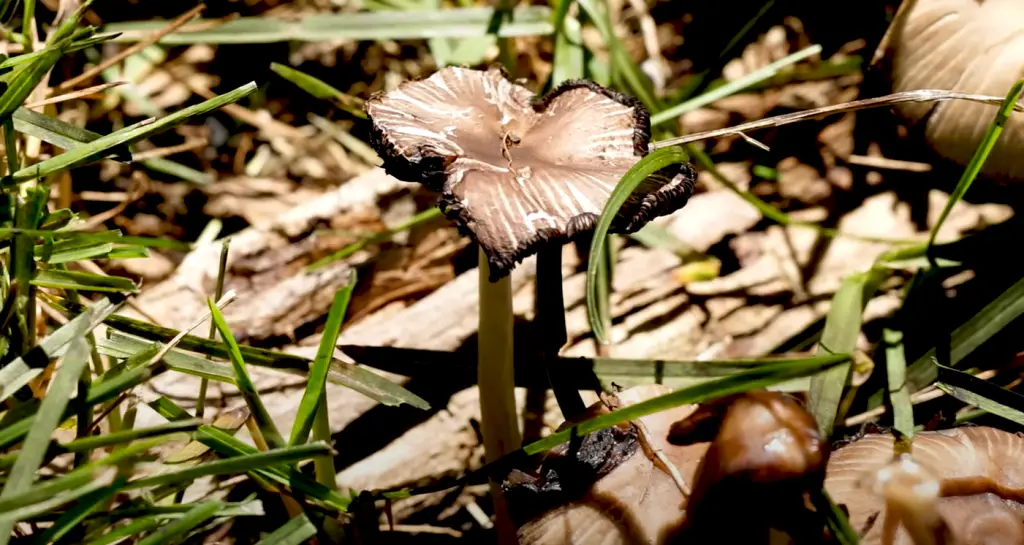
You may also want to create a barrier around mushrooms if you have animals that like to graze in your garden. Barriers will also help to reduce the spore spread. [2],[3]
FAQ
How can a mushroom appear to grow overnight?
Mushrooms are fungi, and like all fungi they reproduce by releasing spores. Spores are tiny cells that travel on the wind or in water and can survive for long periods of time in adverse conditions. When the right conditions exist for growth, a spore will germinate and grow into a new mushroom. Mushrooms can appear to grow overnight because they are often the first part of the fungus to emerge from the ground. The actual fruit bodies of most mushrooms (the caps and stems that we see) are relatively short-lived compared to the underground mycelium (the network of fungal threads) from which they arise. So, when you see a mushroom pop up seemingly out of nowhere, it’s really just the tip of the iceberg!
Are mushrooms grown in poop?
No, mushrooms are not grown in poop. While manure can be used as a substrate to grow mushrooms, it is not necessary for the mushroom mycelium to be in contact with feces in order to fruiting. In fact, most commercially cultivated mushrooms are grown on sterilized substrates that do not contain any feces whatsoever.
Why do mushrooms grow fast?
Mushrooms are able to grow and reproduce very rapidly. The primary reason for this is that they do not need sunlight to grow, unlike most plants. Mushrooms also typically have a very short life cycle, which contributes to their high growth rate.
Another factor that contributes to the mushrooms’ fast growth rate is their ability to break down organic matter quickly. This means that they can extract nutrients from the environment more efficiently than other organisms.
Where do mushrooms grow the most?
Mushrooms love shady, humid places- so your garden is the perfect spot! They often grow near trees or in mulched areas. If you have a lot of mushrooms growing in one area, it likely means that the conditions are ideal for mushroom growth.
To get rid of mushrooms, start by removing any dead leaves or organic matter from your garden. This will make it less hospitable for fungi. You can also try to change the pH of your soil by adding lime or sulfur. Some people also recommend using fungicides, but be sure to read the label carefully before using any chemicals in your garden.
Why do mushrooms suddenly appear?
Mushrooms are the fruit of a fungus that lives in the soil. The main body of the fungus is made up of tiny filaments called hyphae. When conditions are right, the hyphae form a network called mycelium. The mycelium can spread through your garden soil without you even knowing it’s there!
Mushrooms only appear when the fungi produce fruit. The fruiting bodies (mushrooms) grow up through the soil and emerge above ground. Mushrooms can appear very quickly – sometimes overnight! – after rain or watering.
Can I eat the mushrooms growing in my garden?
It is not advisable to eat any mushrooms growing in your garden unless you can positively identify them. Wild mushrooms can be edible, but some are also very toxic and could cause serious illness if consumed. If you do choose to consume a wild mushroom from your garden, it is recommended that an expert or mycologist (mushroom expert) inspects the mushroom for identification before eating. If the mushroom has been identified as edible, ensure that it is cooked thoroughly before consuming. Never attempt to eat a raw wild mushroom of unknown origin or type. Additionally, never attempt to use a field guide to identify mushrooms without help from an experienced professional who can accurately recognize poisonous ones. Consuming a poisonous wild mushroom can lead to nausea, vomiting, and other severe health complications.
Are lawn mushrooms poisonous?
If you have recently found mushrooms growing in your garden, it is important to determine if they are dangerous or not. It is commonly assumed that all mushrooms growing in one’s garden are poisonous, but this is simply not the case. The truth is that some fungi can be dangerous for humans and animals, while others are completely harmless.
To identify which type of mushroom has grown in your garden, there are a few factors to consider such as its shape, texture, color, habitat, season and spore print. If you feel unsure about the type of mushroom growing in your yard then it may be best to contact an expert mycologist who can help identify the species for you. In general though, most lawn mushrooms should not be eaten.
If you do decide to eat mushrooms grown in your garden, it is important to be sure they are not poisonous. Many people mistakenly assume that all mushrooms are safe to consume but this could have serious consequences if the mushroom is toxic. If there is any doubt in your mind, then it’s best to avoid eating them altogether.
Should I get rid of mushrooms in my garden?
Mushrooms in a garden can be both beneficial and detrimental. The mushrooms may be the fruiting bodies of fungi that are actually helping the soil, breaking down organic matter and providing nutrients for plants. Removing them could actually do more harm than good. On the other hand, some mushrooms can be toxic or cause disease or damage to plants and lawns; these should always be removed.
If you are unsure about the type of mushroom growing in your garden, it is best to leave them alone until you have identified them as non-toxic or potentially dangerous. You can contact a local mycologist (mushroom expert) who will come to identify the species and tell you whether they need to be removed or left alone.
In general, once you have identified that the mushrooms are not of any danger to your garden, it is best to leave them alone. Mushrooms help aerate and improve soil quality while adding beneficial microorganisms and enzymes. Whenever possible, try to work with nature by allowing fungi and other organisms in your garden rather than trying to get rid of them. If the mushrooms are located in an area of your garden where they could be a nuisance or cause damage, then you can safely remove them by hand or spot treat with fungicides as necessary.
How to stop mushrooms growing in the garden?
Mushrooms in a garden can be an unwelcome sight. They are not only unsightly but can also spread the spores of other fungi, potentially leading to plant diseases. Fortunately, there are a few steps you can take to reduce or stop mushroom growth in your garden.
The first step is to reduce moisture levels and improve air circulation around the area where mushrooms are growing. If mushrooms are appearing after rain or watering, avoid applying too much water and make sure not to overwater plants as this will encourage fungus growth. Additionally, if possible create space between plants/shrubs so that air can circulate better and dry out the soil more quickly.
You can also try removing existing mushrooms with a hand rake or shovel when they first appear. Thoroughly clean the area and take away any nearby debris, such as mulch or leaves which can create a moist environment where mushrooms will thrive.
Finally, if mushrooms persist you can try using a fungicide to reduce the fungus in your garden. Make sure to read and follow all label instructions carefully when applying fungicides, as they can be hazardous to plants or pets if used incorrectly.
How to get rid of mushrooms in the lawn with vinegar?
Mushrooms are a natural part of any garden, and while they may look beautiful, they can actually be quite dangerous. If you’re noticing mushrooms sprouting up in your lawn, it’s important to take steps to get rid of them as soon as possible. One method for removing mushrooms from the lawn is to use vinegar.
To remove mushrooms from your lawn using vinegar, start by identifying the type of mushroom growing in your yard. Once identified, mix white distilled vinegar with water in a ratio of one-to-one. Place the mixture into a spray bottle and thoroughly spray the mushrooms with it repeatedly until they begin to dry out and die back. If you need additional help getting rid of the mushrooms, you can also add a few drops of liquid dish soap to the vinegar and water mixture, as this will help to break down the cell walls of the mushrooms.
Once the mushrooms are dead and dried out, rake them up and discard them in an outdoor trash bin. Regularly checking your yard for any new growths of mushrooms is important, as some species can spread rapidly in ideal conditions. If you find that mushroom removal becomes too difficult or time consuming with DIY methods, it’s best to call a professional for assistance.
Why are white mushrooms growing in my yard?
White mushrooms typically grow in moist, shady conditions and are most commonly seen in lawns that have had too much water or insufficient drainage. If you’re seeing white mushrooms sprouting up in your yard, it’s important to figure out the cause of the excessive moisture before taking steps to remove them. Some solutions for preventing future growth may involve improving soil drainage, planting grass species more tolerant of wet conditions, or adjusting your watering schedule so that less moisture is available for mushrooms to thrive on.
Why are brown mushrooms growing in my yard?
Brown mushrooms, or toadstools, sprout up in yards and gardens for a variety of reasons. The primary cause is the presence of fungus in the soil, though environmental factors such as moisture, temperature, and light can also play a role. Understanding why mushrooms are growing on your property will help you take steps to prevent them from popping up again.
Fungi are naturally present in soil, which means they’re always ready to grow in moist conditions. In fact, some fungi need wet conditions to survive – so if you’ve had a particularly damp summer or spring season, your yard could be more susceptible to mushroom growth. Additionally, mushrooms tend to thrive when the temperature hovers between 55-70°F (13-21°C) – temperatures which are common in spring and fall.
Light can also be a factor in mushroom growth, as some species need full sun or partial shade to sprout up. This means that if your yard gets ample sunlight, mushrooms may start popping up more often.
Finally, the type of soil you have could influence the presence of mushrooms in your garden. Mushroom spores are attracted to nitrogen-rich soil and organic matter like compost – so if you’ve recently added these substances to your yard, you may find more mushrooms growing than usual.
What happens if you touch a mushroom in the grass?
It’s important to exercise caution when handling mushrooms in your yard, as some species can be toxic. If you do come into contact with a mushroom, it’s best to wash your hands thoroughly afterwards. Additionally, avoid eating any wild mushrooms without consulting an expert first – there are many poisonous varieties that could make you seriously ill.
Is it easy to tell if a mushroom is poisonous just by looking at it?
Unfortunately, the answer is no. It can be very difficult to tell if a mushroom is safe to eat or not just from its appearance alone. This is why it’s important to understand why mushrooms are sprouting in your garden and how to identify them properly.
Mushrooms are actually part of a larger group of organisms called fungi. They typically grow where there is plenty of moisture, such as in damp soil or near sources of water like ponds and streams. Mushrooms also need organic matter in order to survive, which means they will often thrive in gardens with compost piles or areas with decaying leaves and wood chips.
If you have mushrooms growing in your garden, it could be due to excess moisture or nutrient-rich soil. There are also some species of mushrooms that are saprophytic, meaning they live off dead or decaying materials. In this case, the mushrooms may be feeding on decomposing organic matter in your garden.
In order to prevent mushrooms from growing in your garden, you should make sure the soil is not overly moist and there is no excess organic matter for them to feed on. You can also add fungicides to the soil as a preventative measure against any potential fungi growth.
Useful Video: Why Are Mushrooms Growing in My Garden?
Conclusion
Mushrooms are nocturnal creatures that often go unnoticed in our gardens. But sometimes they require you to take action. Mushrooms are a type of fungus that generally grow in damp, dark places. While most Mushroom species are not harmful, some can be poisonous if ingested. So, it’s important to be able to identify them and know whether or not they pose a threat to your family or pets. If you have questions about why mushrooms are growing in your garden, this guide should help you out. Keep an eye out for these fungi and take action accordingly to ensure a healthy garden. Thanks for reading!
References:
- https://www.gardenersworld.com/plants/garden-mushroom-identifier/
- https://www.masterclass.com/articles/how-to-get-rid-of-mushrooms-in-yard-guide#6-strategies-for-getting-rid-of-mushrooms
- https://www.lovethegarden.com/uk-en/article/how-prevent-mushrooms-lawn










Leave a Reply
View Comments